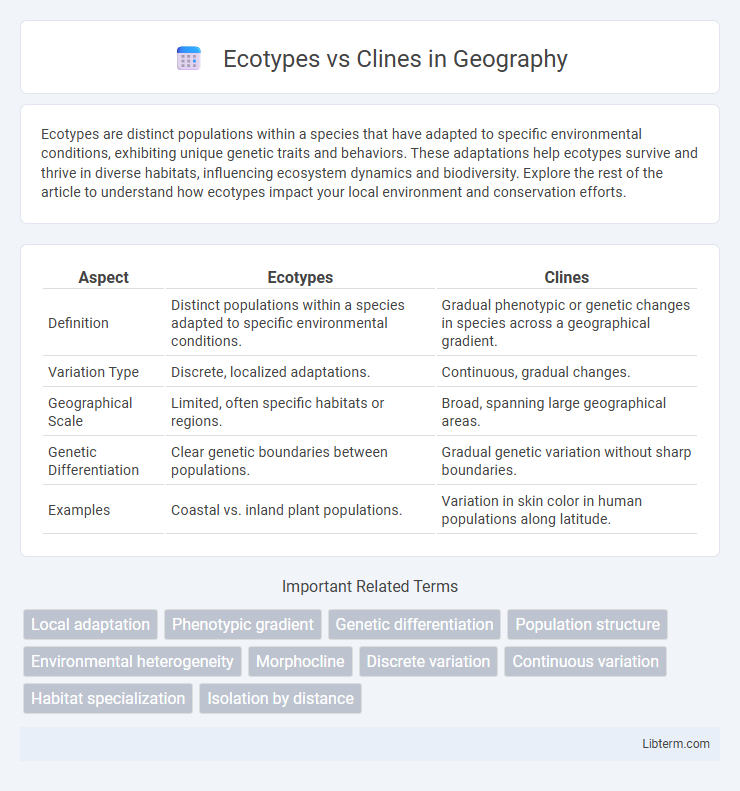Ecotypes are distinct populations within a species that have adapted to specific environmental conditions, exhibiting unique genetic traits and behaviors. These adaptations help ecotypes survive and thrive in diverse habitats, influencing ecosystem dynamics and biodiversity. Explore the rest of the article to understand how ecotypes impact your local environment and conservation efforts.
Table of Comparison
| Aspect | Ecotypes | Clines |
|---|---|---|
| Definition | Distinct populations within a species adapted to specific environmental conditions. | Gradual phenotypic or genetic changes in species across a geographical gradient. |
| Variation Type | Discrete, localized adaptations. | Continuous, gradual changes. |
| Geographical Scale | Limited, often specific habitats or regions. | Broad, spanning large geographical areas. |
| Genetic Differentiation | Clear genetic boundaries between populations. | Gradual genetic variation without sharp boundaries. |
| Examples | Coastal vs. inland plant populations. | Variation in skin color in human populations along latitude. |
Introduction to Ecotypes and Clines
Ecotypes represent distinct populations within a species that have adapted to specific environmental conditions, resulting in genetic differentiation and unique phenotypic traits. Clines describe gradual phenotypic or genetic changes in a species across geographical gradients, often correlating with environmental variables such as temperature or altitude. Understanding ecotypes and clines is essential for studying evolutionary processes, biodiversity, and species adaptation to changing habitats.
Defining Ecotypes: Distinct Adaptations
Ecotypes represent genetically distinct populations within a species, adapted to specific environmental conditions and showing unique morphological or physiological traits. These adaptations are driven by localized selection pressures, resulting in discrete variations that facilitate survival in particular habitats. Unlike clines, which display gradual phenotypic changes across geographic gradients, ecotypes maintain clear boundaries and specialized characteristics tied to distinct ecological niches.
Understanding Clines: Gradual Variation
Clines represent gradual, continuous changes in a species' traits or allele frequencies along environmental or geographical gradients, illustrating adaptive responses without distinct population boundaries. These gradual variations reflect genetic diversity shaped by factors like temperature, altitude, or humidity, enabling populations to thrive across diverse habitats. Understanding clines is essential for studying evolutionary processes and predicting species' responses to environmental changes.
Genetic Basis of Ecotypes
Ecotypes exhibit distinct genetic adaptations to specific environmental conditions, resulting in discrete populations with unique allele frequencies and phenotypic traits. Genetic divergence in ecotypes is often driven by natural selection acting on heritable variations that confer survival advantages in heterogeneous habitats. Unlike clines, which show gradual genetic and phenotypic changes over geographical gradients, ecotypes maintain sharp genetic boundaries reflecting localized adaptation.
Environmental Gradients and Clines
Environmental gradients such as temperature, altitude, or moisture drive clinal variations by producing continuous changes in phenotypic traits and allele frequencies across geographic ranges. Clines represent gradual shifts in genetic and morphological characteristics correlated with these gradients, reflecting adaptive responses to spatially varying environments. Unlike ecotypes, which form discrete populations adapted to specific habitats, clines emphasize the smooth transition of traits along environmental gradients without sharp boundaries.
Examples of Ecotypes in Nature
Ecotypes represent genetically distinct populations within a species adapted to specific environmental conditions, such as the different ecotypes of the European white oak (Quercus robur) that thrive in coastal versus inland habitats. Another classic example is the beach and forest ecotypes of the perennial plant Solidago altissima, where genetic divergence corresponds to contrasting soil and light conditions. These ecotypes demonstrate localized adaptation, maintaining distinct genetic traits despite potential gene flow across the species range.
Real-world Cases of Clinal Variation
Clines demonstrate gradual changes in phenotypic or genetic traits across geographical gradients, exemplified by the varying skin pigmentation in human populations correlated with latitude and UV exposure levels. Another real-world case is the body size variation in Allen's rule, where animals in colder climates exhibit shorter limbs compared to those in warmer regions to conserve heat. These clinal variations highlight adaptive responses to environmental pressures, distinguishing them from ecotypes that typically show discrete genetic differentiation linked to specific habitats.
Mechanisms Driving Ecotypes and Clines
Ecotypes arise through local adaptation driven by natural selection acting on genetic variation within populations, often resulting from discrete environmental differences that create distinct habitat patches promoting reproductive isolation. Clines are shaped by gradual environmental gradients where gene flow and selection pressures create continuous phenotypic or genetic variation across geographic ranges. Mechanisms driving both include differential selection intensity, genetic drift, mutation rates, and migration patterns influencing allele frequencies and trait distributions along spatial and ecological dimensions.
Significance in Evolution and Speciation
Ecotypes represent distinct populations within a species adapted to specific environmental conditions, driving local adaptation and genetic differentiation essential for speciation. Clines illustrate gradual phenotypic or genetic changes across geographical gradients, reflecting ongoing gene flow and selection pressures that shape evolutionary trajectories. Understanding ecotypes and clines is pivotal for studying adaptive divergence, reproductive isolation, and the emergence of new species in evolutionary biology.
Ecotypes vs Clines: Key Differences and Implications
Ecotypes represent distinct populations within a species adapted to specific environmental conditions, exhibiting clear genetic and phenotypic differences, while clines describe gradual changes in traits or allele frequencies across geographical gradients. The key differences lie in the discrete nature of ecotypes compared to the continuous variation seen in clines, impacting ecological studies and conservation strategies by defining population boundaries versus gradient-based diversity. Understanding these distinctions aids in predicting species' responses to environmental changes and in managing biodiversity effectively.
Ecotypes Infographic

 libterm.com
libterm.com